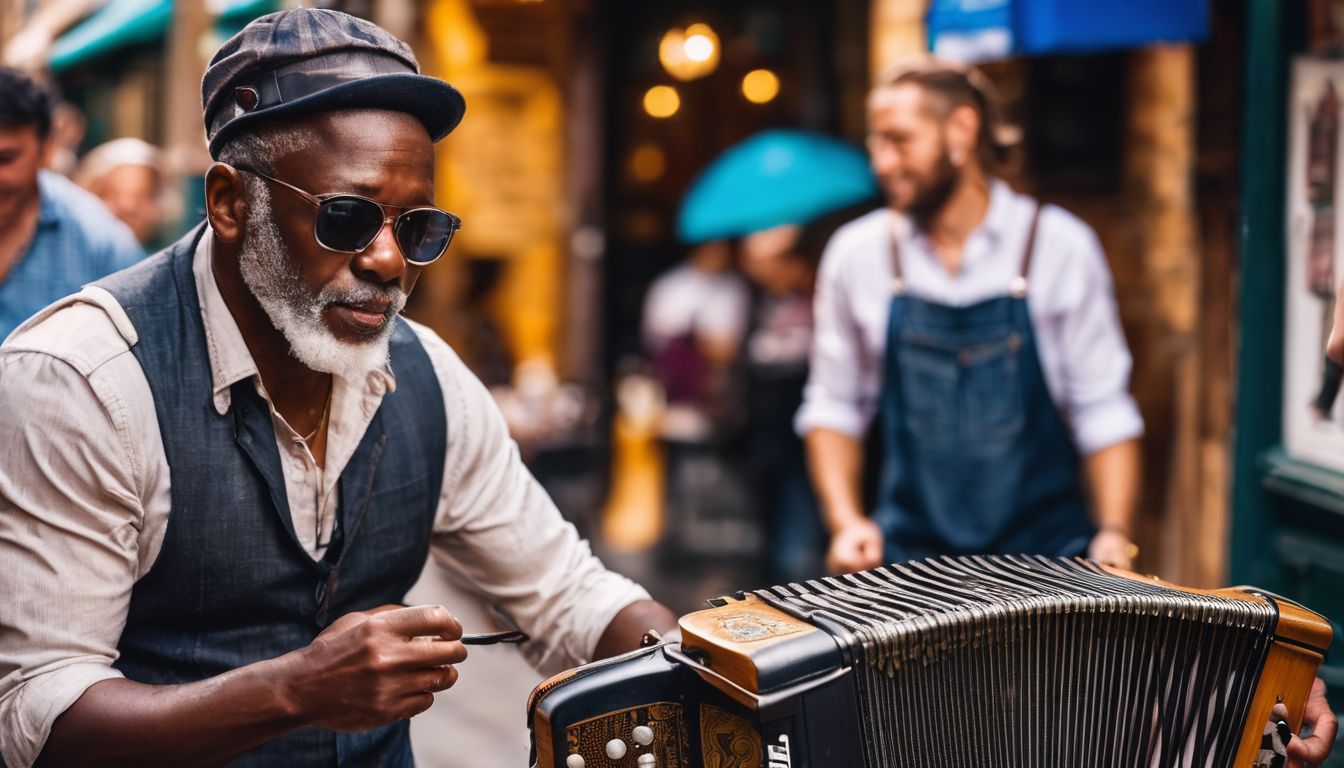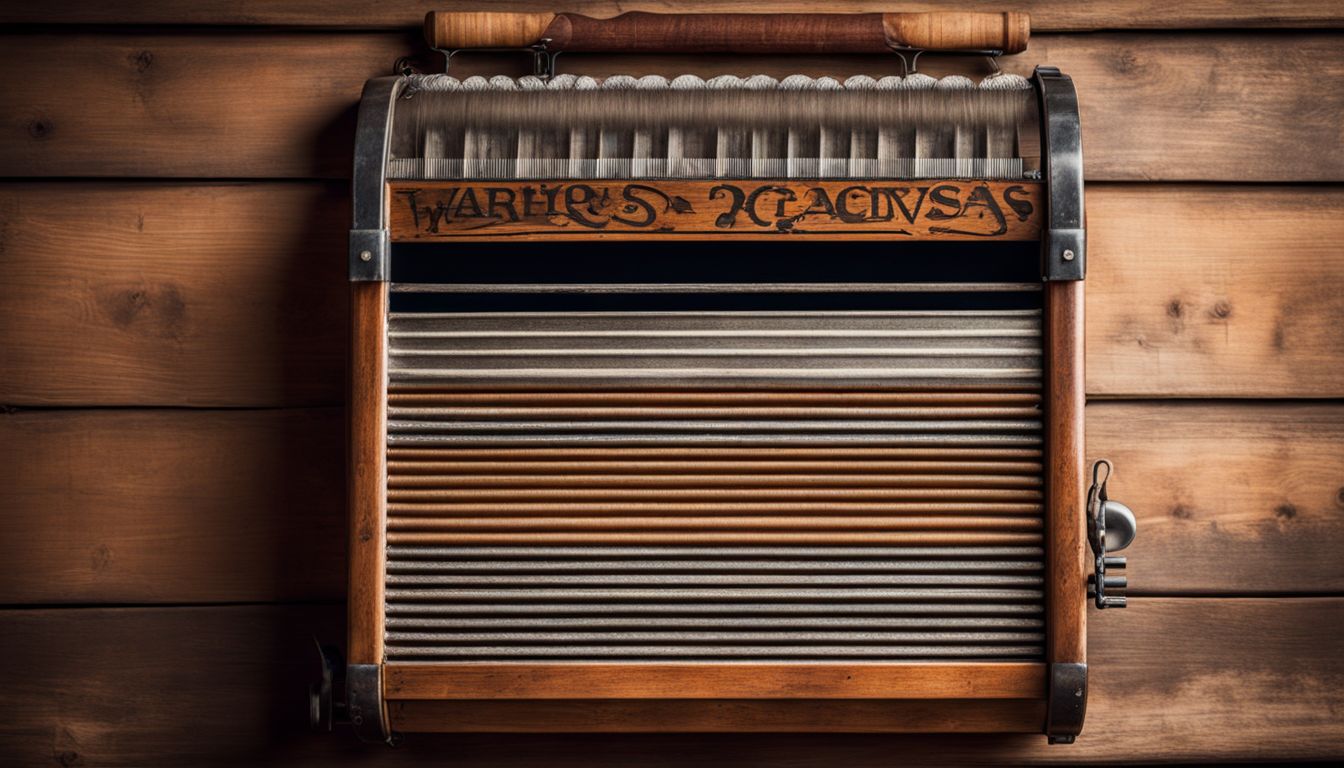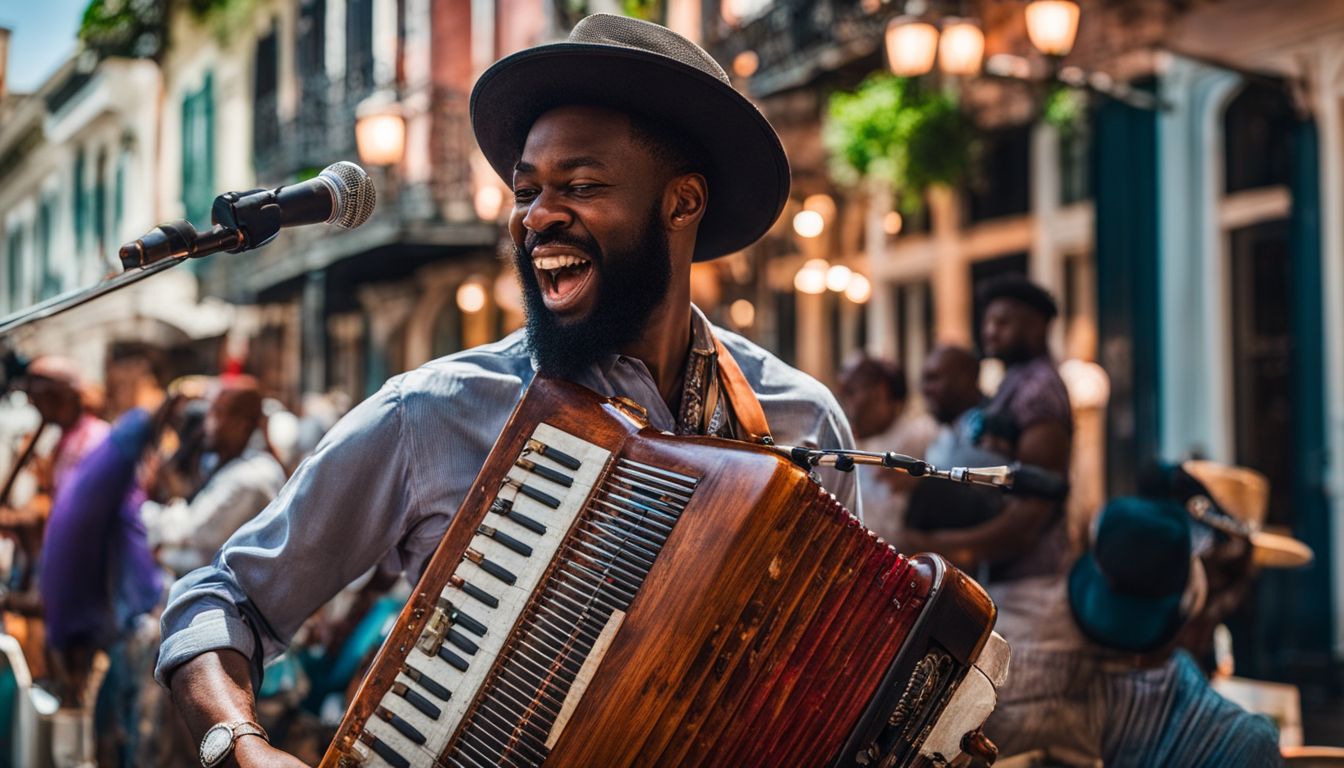Have you ever heard a rhythm that made you tap your feet but couldn’t spot the drums? This upbeat sound may have come from an unlikely hero in music: the washboard. Used for decades to add zest to various music genres, this ribbed surface turns laundry into lively tunes.
Our article will guide you through its fascinating role and techniques so you can appreciate every scrape and tap. Get ready to be amazed!
Key Takeaways
- Musicians transformed washboards, originally used for laundry, into percussive instruments by using thimbles and various objects to create a range of rhythmic sounds.
- The instrument found its roots in African-American jug bands and skiffle groups in the early 20th century and later became an integral part of jazz, notably within the New Orleans music scene.
- Notable washboard players, including Washboard Chaz, Ralf Reynolds, and Cody Dickinson, have developed unique styles and techniques that contribute to various music genres, from blues to rock’n’roll.
- Different playing methods on the washboard can produce varied rhythms and textures: scratching with thimbles creates a staccato effect, while tapping or sliding objects across it adds depth.
- As musical innovation progressed, percussive instruments evolved from simple items like washboards to complex equipment like turntables used by DJs for scratching and mixing.
Understanding the Washboard as a Musical Instrument
The washboard may look simple, but it’s an ingenious instrument in the right hands. Originally a tool for scrubbing clothes, musicians saw beyond its humble beginnings and turned it into a rhythm-making powerhouse.
They rub thimbles against its corrugated surface to produce crisp, staccato sounds that can drive the beat of a song as effectively as any drum set. Musicians have adapted various items, like wooden spoons or whisk brooms, to strike or scrape across the metal ridges, creating unique rhythms that are signature to jug band and zydeco styles.
Players wear the frottoir strapped over their chests while standing up, allowing them freedom of movement and expression as they play alongside bassists and guitarists. The horizontal lap method provides stability for vigorous playing styles with more elaborate techniques.
Whether draped vertically down their torsos or clasped between knees while seated, washboard players contribute dynamic percussion layers essential for giving life to musical numbers across genres, from skiffle bands in England to blues groups in America’s Deep South.
The History of the Washboard in Music
Washboard instruments found their musical roots in the African-American communities of the early 20th century, where they were a staple in jug bands and skiffle groups. Originally designed for scrubbing clothes, these ribbed metal or wood boards quickly showcased their rhythmic potential when played with thimbles on the fingers.
Players would scrape, tap, and hit using a variety of household objects to produce a range of percussive sounds that complemented the banjos, jugs, kazoos, and harmonicas commonly used in ensembles of that era.
As washboard percussion gained popularity due to its affordability and portability, it became an integral part of jazz’s development during the Roaring Twenties. In New Orleans’ bustling music scene, performers like Washboard Chaz pioneered techniques that turned this laundry tool into an essential rhythm instrument.
Musicians have expanded its use beyond jazz to other genres such as zydeco music—a blend that marries Creole rhythms with blues—where they wear customized rubboards called frottoirs like vests for more energetic playing styles.
Notable Washboard Performers
The world of music has seen several talented washboard players who have carved a niche for themselves. These musicians showcase the versatility and joy that come from this unconventional percussion instrument.
- Washboard Chaz leads the pack with his bluesy touch, having become an icon in the New Orleans music scene.
- Ralf Reynolds brings a unique flair to traditional jazz, contributing greatly to the revival of washboard music.
- David Langlois innovates by blending different musical styles, which makes his washboard performances stand out.
- Ben Turner takes it back to the roots with rhythms that tell stories of eras past.
- Stephane Seva demonstrates mastery over the washboard in genres ranging from gypsy jazz to French folk tunes.
- Washboard Sam, one of the old-time greats, solidified his legacy with classic blues numbers that still resonate today.
- Súle Greg Wilson adds a modern twist to the instrument by incorporating African American historical elements into his style.
- Deryck Guyler delighted audiences across Britain with his comedic and rhythmic prowess on the washboard stage.
Techniques for Playing the Washboard
Playing the washboard isn’t just about keeping time; it’s a dynamic way to contribute to the rhythmic backbone of any song. With the right techniques, you can turn this simple tool into a complex, captivating musical instrument.
- Grasp your thimbles or finger picks firmly and use them to strike down along the ridges for a basic scratching sound. This motion is similar to strumming a guitar and forms the core of washboard playing.
- Explore various objects, like spoons or brushes, to tap and hit different areas on the washboard, creating unique tones and textures in your music.
- Slide metal objects, such as bottle openers, across the ridges for a longer, wailing sound that adds depth to tunes when timed well.
- Integrate short, sharp taps with your fingertips between long scratches for an intricate pattern that can mimic shakers or tambourines.
- Varying pressure as you play will produce different volumes; press harder for louder sounds and lighten up for quieter ones, adding expression to your performance.
- Utilize the entire surface of the washboard by moving your hands around; each section can yield distinct pitches, which help diversify rhythms.
- Double up on tempo by using both hands in alternating fashion—this advanced technique speeds up rhythms without losing clarity or precision.
- Incorporate foot stomping or knee slapping while playing to further enhance the percussive elements and drive of the music.
Different Sounds and Rhythms Achieved with a Washboard
Musicians manipulate the ridges of a washboard to create unique beats and textures comparable to drumming patterns. They achieve high-pitched tinkling sounds by tapping with thimbles on their fingers; this technique is particularly effective for creating intricate rhythms.
Scraping different objects over the metal grooves produces varied effects: metal produces a harsher sound, while wood offers a softer tone.
Experimentation leads to discovering other methods that deliver diverse effects, much like how Newman Taylor Baker explores unconventional approaches in his performances. Some players use brushes or sticks similar to those used in jazz drumming for smoother sounds, adding layers of complexity to their music.
The combination of striking surfaces and scratching techniques allows artists such as Steve Katz or Stefan Grossman, known for their skillful blend of folk traditions and modern interpretations, to provide audiences with an auditory experience rich in rhythmic variation and melodic percussion.
The Evolution of Percussive Instruments: From Washboards to Turntablism
Percussive instruments have undergone a remarkable transformation since the days of the washboard. These simple ribbed boards, once used for laundry, became musical mainstays in various styles, such as jazz and country music.
Vibrant rhythms echoed from their metal surfaces under the skilled hands of musicians who employed spoons or thimbles to coax out syncopated beats. As time progressed, this ingenuity paved the way for more sophisticated instruments.
Enter turntablism—a revolutionary leap in percussive expression that emerged prominently during the late 20th century. DJs turned record players into modern-day instruments through techniques like scratching and mixing, creating entirely new soundscapes seasoned with rhythm and beat manipulation.
This innovation not only redefined what it means to be a percussionist but also expanded the possibilities within musical composition itself. Turntables pushed traditional boundaries, signaling an evolved era of sounds triggered by creativity across centuries of rhythmic exploration.
Comparison between Musical Washboards and Traditional Washboards
Understanding the distinction between musical washboards and traditional washboards is key to appreciating their roles and evolution. Let’s dive into the comparison.
| Musical Washboards | Traditional Washboards |
| Adapted for musical expression | Originally designed for laundry |
| Played as a percussive instrument | Used as a tool for scrubbing clothes |
| Features and modifications for sound enhancement | Simple construction with a primary focus on durability |
| Includes attachments like thimbles and sticks | Lacks musical accessories |
| Often made from more resonant materials | Typically constructed from wood and metal |
| Portability is essential for performances | Portability is not a primary concern |
| The frottoir is a specialized version for Zydeco music | No specialized versions, primarily utilitarian |
| Can be played in various orientations and styles | Used in a singular, practical manner |
Musical washboards have transcended their original purpose, turning a household tool into a source of rhythm and joy. They showcase the innovative spirit in music, where even the most mundane items can find new life as instruments.
Conclusion
The washboard resonates as a unique voice in the world of music, turning an everyday item into a rhythmic powerhouse. The washboard’s transformation from laundry tool to stage staple reflects the creativity ingrained in musical culture.
Artists worldwide continue to tap into its distinctive sound, mixing tradition with innovation. The joy of making music with this unassuming instrument proves that sometimes it’s the simple things that hold the richest tunes.
Embrace the washboard’s percussive potential and let your rhythm flow!
FAQs
What exactly is a washboard in music?
Originally used for scrubbing linens, a washboard in music is a musical instrument. Musicians play it by rubbing thimbles on their fingers across its ridged metal surface to make rhythmical, percussive sounds.
How do you create music with a washboard?
To produce music with a washboard, the player taps, scrapes, and strikes the ribs of the board with various objects to create different sounds. This can add unique beats to songs, especially in folk or jug band styles where it often serves as percussion.
Can anyone learn to play the washboard?
Absolutely! Playing the musical instrument known as a washboard doesn’t require formal training; it’s all about rhythm and timing. With some practice, just about anyone can pick up this skill and add flair to their musical performances.
In what type of performance might one see a washboard being used?
Musicians playing washboards can often be spotted at live folk concerts or within genres like zydeco and country blues bands; they bring an authentic ‘bendin’ in the wind’ vibe that gets audiences tapping along.


